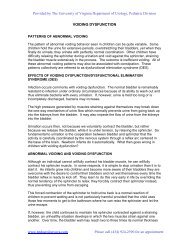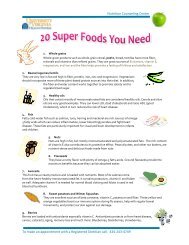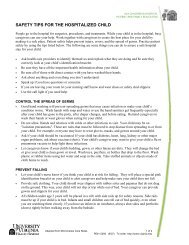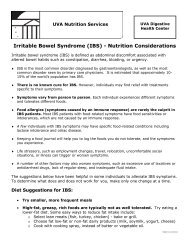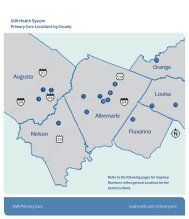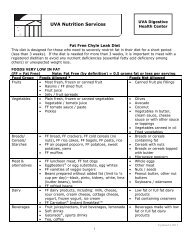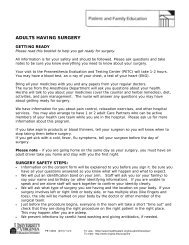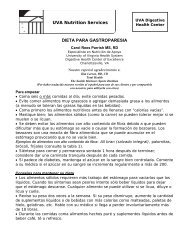Escala para calificar el dolor en UVA - University of Virginia Health ...
Escala para calificar el dolor en UVA - University of Virginia Health ...
Escala para calificar el dolor en UVA - University of Virginia Health ...
Create successful ePaper yourself
Turn your PDF publications into a flip-book with our unique Google optimized e-Paper software.
<strong>UVA</strong> PAIN RATING SCALE<br />
0<br />
PAIN RATING<br />
10<br />
9<br />
8<br />
7<br />
6<br />
5<br />
4<br />
3<br />
2<br />
1<br />
PATIENT AND FAMILY EDUCATION<br />
ACTIVITY RATING<br />
Worst possible pain<br />
Unable to do any activities because <strong>of</strong> pain<br />
Extreme pain<br />
Unable to do most activities because <strong>of</strong> pain<br />
Severe pain<br />
Unable to do some activities because <strong>of</strong> pain<br />
Moderate pain<br />
Can do most activities with rest periods<br />
Mild pain<br />
Pain is pres<strong>en</strong>t but does not limit activity<br />
No pain<br />
Able to do all activities<br />
Faces: Modified from Wong DL: Whaley & Wong’s ess<strong>en</strong>tials <strong>of</strong><br />
pediatric nursing, ed 5, pp1215-16, St. Louis, 1997, Mosby.<br />
Used with permission.<br />
Thermometer: Used with permission from Ke<strong>el</strong>a Herr,<br />
<strong>University</strong> <strong>of</strong> Iowa.<br />
PE 15019-C (2/11) 1 <strong>of</strong> 2 To view: https://www.healthsystem.virginia.edu/intranet/per/<br />
To order: http://www.virginia.edu/uvaprint/
GUIDELINES FOR THE <strong>UVA</strong> PAIN SCALE<br />
The <strong>UVA</strong> Pain Scale is a combination <strong>of</strong> the three validated scales: The<br />
Wong-Baker Face Scale, The Iowa Pain Thermometer, and the Functional<br />
Pain or Activity Rating scale (functional descriptors). Combining the three<br />
scales with pictures, numbers, and functional words provides up-to-date and<br />
most commonly used means to describe the pati<strong>en</strong>t’s pain.<br />
DURING ASSESSMENT/REASSESSMENT:<br />
1. For pati<strong>en</strong>ts who can communicate:<br />
• Show the scale to your pati<strong>en</strong>ts and briefly explain that they can rate their pain<br />
using numbers, faces, or words. Fe<strong>el</strong>ings <strong>of</strong> anxiety and depression can also<br />
affect pain and should be addressed. These scales are validated for pain lev<strong>el</strong>.<br />
•<br />
• Docum<strong>en</strong>t the pain scale number that corresponds to the faces or the lev<strong>el</strong> <strong>of</strong> the<br />
thermometer.<br />
AND/OR<br />
• Docum<strong>en</strong>t the words used in the comm<strong>en</strong>t section <strong>of</strong> the daily flowsheet if the<br />
pati<strong>en</strong>t is visually impaired or cannot id<strong>en</strong>tify a number or face.<br />
○ Wong-Baker FACES Pain Rating Scale I : Point to each face using the<br />
words to describe the pain int<strong>en</strong>sity. Ask the pati<strong>en</strong>t to choose a face that<br />
best describes the pain and record the appropriate number.<br />
○ The Modified Iowa Pain Thermometer (IPT) II Pain rating score 0 to 10<br />
aligns with a pain thermometer to visually h<strong>el</strong>p pati<strong>en</strong>t to see range <strong>of</strong><br />
pain rating.<br />
○ The Functional Pain Scale (FPS) referred to as ACTIVITY RATING: Ask<br />
questions or observe the pati<strong>en</strong>t to determine if the pain interferes with<br />
function. FPS is especially h<strong>el</strong>pful if the pati<strong>en</strong>t has visual or cognitive<br />
impairm<strong>en</strong>ts.<br />
2. For nonverbal pati<strong>en</strong>ts<br />
• Describe pain behaviors and assume pain pres<strong>en</strong>t if there is a reason to suspect<br />
pain (APP).<br />
_______________________<br />
I<br />
From Wong DL, Hock<strong>en</strong>berry-Eaton M, Wilson D, Wink<strong>el</strong>stein ML, Schwartz P: Wong’s Ess<strong>en</strong>tials<br />
<strong>of</strong> Pediatric Nursing, 6/e, St. Louis, 2001, P. 1301.<br />
ii<br />
Other pr<strong>el</strong>iminary testing <strong>of</strong> the IPT with Caucasian and minority older adults including African-<br />
Americans and Hispanics, has found it to be r<strong>el</strong>iable and valid and the preferred scale by many<br />
subjects. Permission for use granted by Ke<strong>el</strong>a Herr, PhD, RN. <strong>University</strong> <strong>of</strong> Iowa.<br />
2 <strong>of</strong> 2





